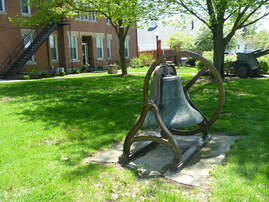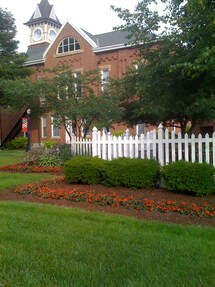Monroe Township Hall (better known as the Town Hall)
|
In 1813 Dr. Bigelow laid out Johnstown which was incorporated into the State of Ohio.
He set aside land at the intersection of Columbus Road and Newark Road for a public square which fondly became known as the “Park Yard.” He also set aside land for a cemetery on West Coshocton Street. In 1817 he died and was interred in the cemetery which has been called "Pioneer Cemetery" but officially is "Bigelow Cemetery". His gravestone remains. at this cemetery. |
The Park Yard remained as an open green space for sixty six years after our founder’s death. However, in 1883 Elijah Barton was contracted to build the Monroe Township Hall and Opera House on this property. This impressive structure of brick was completed in 1884. On January 1, 1885 the dedicated building became known as the “Town Hall”. The ground level rooms have served over the years as a ballroom for dances, meeting place for township trustees and village council, offices for the mayor and police, the town library, and now a museum for the Johnstown Historical Society.The 325 seat Opera House on the second floor has hosted graduations, weddings, lectures, ceremonies, plays, variety shows, minstrels, concerts, plays, auctions, and speeches. A plaque "Bigelow Park" reminds us of our founder's vision.
|
Town Hall Bell

The town hall bell was not always located on this grassy area. In 1907 it was positioned in the town hall cupola and was often used to toll funerals, big events, like the end of World War I, polls opening on Election Days and even got to work a little on Halloween to remind youth about curfew hours. It was also used during the Civilian Defense program of the village during the various war years.
The bell weighs a total of 1300 pounds. It was made at the J. B. Foote Foundry Company in Fredericktown, Ohio.
The bell weighs a total of 1300 pounds. It was made at the J. B. Foote Foundry Company in Fredericktown, Ohio.
The Town Square (Bigelow Park) at Johnstown, Ohio
The town square was a gift of Oliver Bigelow when he laid out Johnstown in 1813. The square is called Bigelow Park in his honor. Bigelow died in 1817, but his dream became a reality in 1883 when Elijah Barton began the Town Hall/Opera House. The plaque outside notes that this edifice completed in 1885 is to be known as the Monroe Township Building.
On January 1, 1885 it was dedicated “forever” to the village. It was considered the civic center of the Village. Today the Monroe Township Trustees have control of the building and land adjacent, and the Village Council controls the land adjoining the twenty foot strip of land next to the building. Currently, the Johnstown Historical Society has a museum and offices on the first floor.
The Town Hall/Opera House is a two story building. The raised stage of the Opera House once hosted lectures, plays, musical revivals, political rallies, the unforgettable medicine shows and vaudeville acts, as well as high school graduation ceremonies. Today it is still used for plays and musical events.
The old backdrops made by Armbruster and Son in 1885 are still being used. The Swiss Alps mural is a fascinating scene with its houses perched on high crags, and ranging from mountain streams to narrow bridges.
The Town-Hall Opera House is on the National Register of Historic Buildings due to the efforts of the Johnstown Historical Society and the Monroe Township Trustees. It has seating for 290 people.
Ohio once had over 50 opera houses, but today, only a few still exist:
The town square was a gift of Oliver Bigelow when he laid out Johnstown in 1813. The square is called Bigelow Park in his honor. Bigelow died in 1817, but his dream became a reality in 1883 when Elijah Barton began the Town Hall/Opera House. The plaque outside notes that this edifice completed in 1885 is to be known as the Monroe Township Building.
On January 1, 1885 it was dedicated “forever” to the village. It was considered the civic center of the Village. Today the Monroe Township Trustees have control of the building and land adjacent, and the Village Council controls the land adjoining the twenty foot strip of land next to the building. Currently, the Johnstown Historical Society has a museum and offices on the first floor.
The Town Hall/Opera House is a two story building. The raised stage of the Opera House once hosted lectures, plays, musical revivals, political rallies, the unforgettable medicine shows and vaudeville acts, as well as high school graduation ceremonies. Today it is still used for plays and musical events.
The old backdrops made by Armbruster and Son in 1885 are still being used. The Swiss Alps mural is a fascinating scene with its houses perched on high crags, and ranging from mountain streams to narrow bridges.
The Town-Hall Opera House is on the National Register of Historic Buildings due to the efforts of the Johnstown Historical Society and the Monroe Township Trustees. It has seating for 290 people.
Ohio once had over 50 opera houses, but today, only a few still exist:

